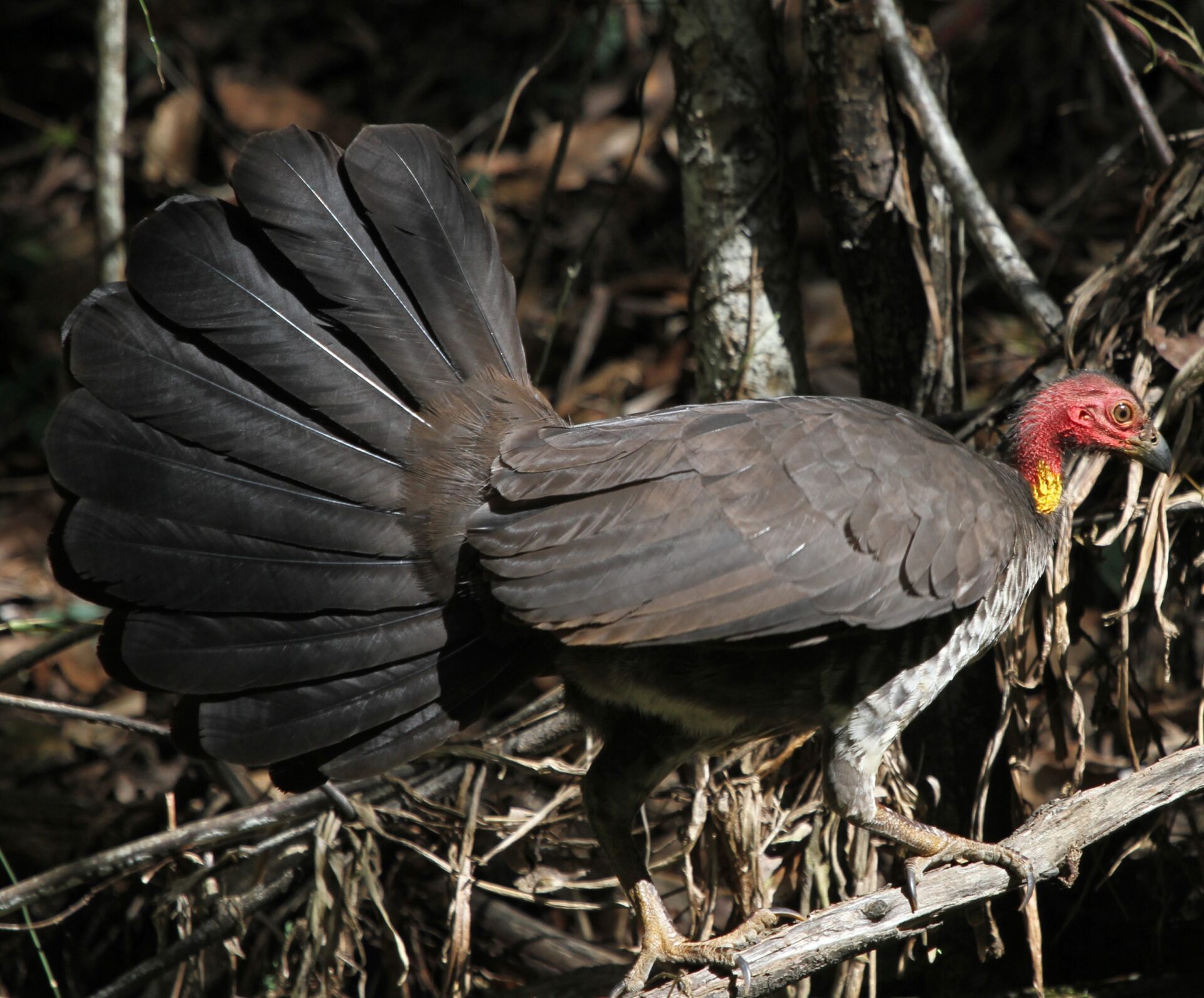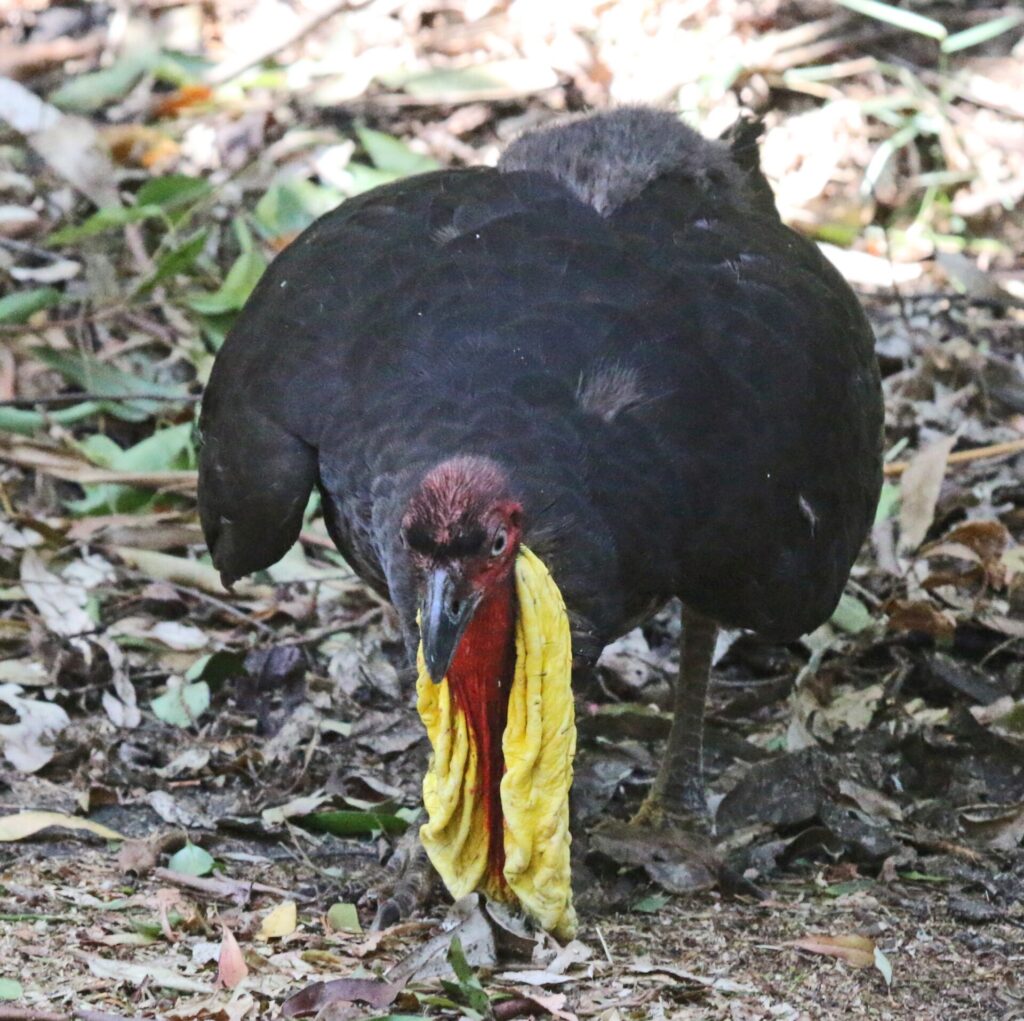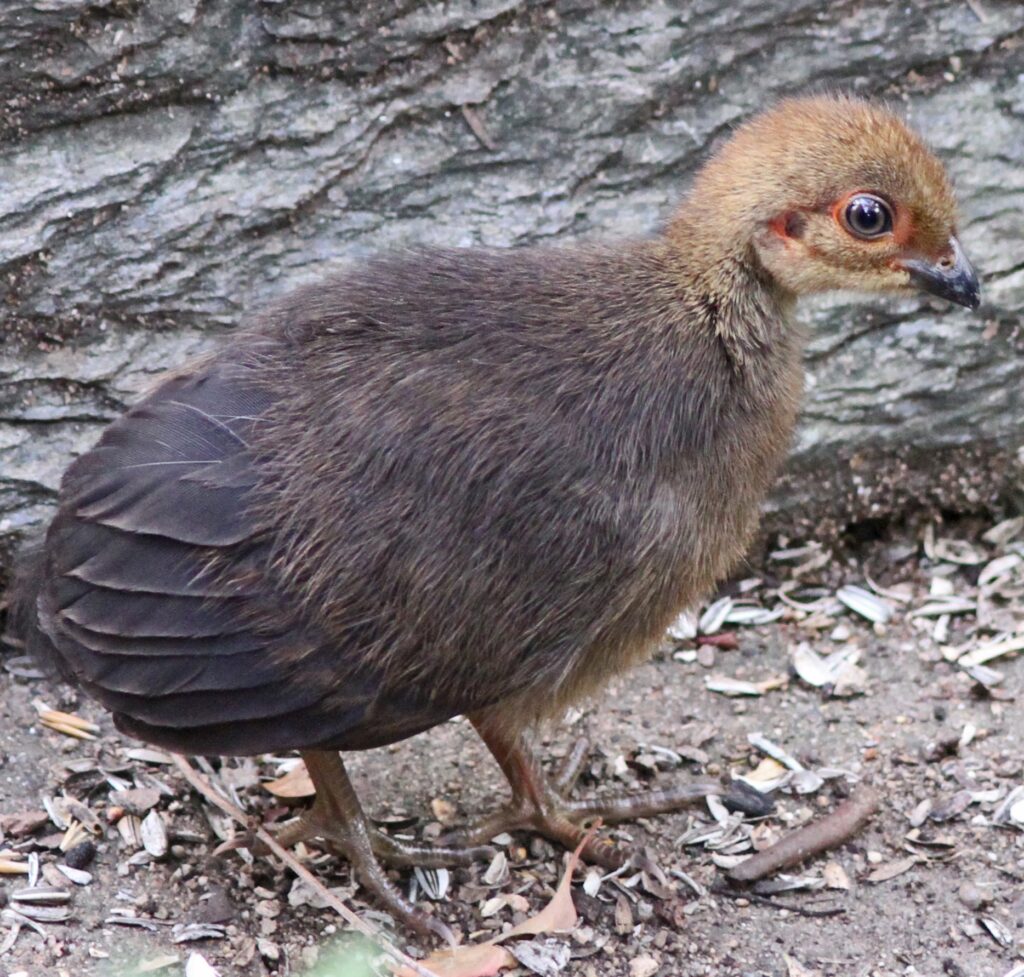The first Australian Brushturkey appeared in our inner western Brisbane backyard in the early 1980s. In the past few decades they have expanded through most of Brisbane. Their range extends from the tip of Cape York along the coastal strip east of the Dividing Range and south as far as Wollongong.

They are one of the three species of mound-builders in Australia along with the Malleefowl and the Orange-footed Scrubfowl. Brushturkeys are 60-70cm long, mainly black, with vertical fanned tails and very strong legs.

Breeding males have a bright yellow pouch (purple in North Queensland) surrounding the base of their neck, often dangling almost to the ground. Chicks are brown and downy with well-developed primaries at hatching. They eat fruit, seeds, insects, worms and sometimes reptiles or carrion – almost anything they can find. We have seen one expertly tip over a half-empty Coke can and drink the contents!
Chicks are usually solitary, though adults may form loose groups when they are not breeding. They are sedentary. The Australian Bird and Bat Banding Scheme shows that birds moved an average of 2 km between capture and recapture or sighting, and a maximum of 26 km. This may raise questions about the common practice of re-locating adult birds causing “problems” in gardens.

Brushturkeys have a deep, resonant call, as well as making quiet grunts. They arch their necks forward when calling. Their call pales into insignificance compared with the cackling and shrieking call of Queensland’s other mound-builder, the Orange-footed Scrubfowl.
Each breeding male Brushturkey builds an enormous mound of leaf litter and mulch, usually starting after the first significant rainfall after the end of May. Mounds can contain over 2000kg of damp soil and vegetable matter. Males tend their mounds carefully, adding material and removing it, presumably to maintain an optimal internal temperature for incubating eggs. We have watched a male remove perhaps half of his mound and spread it out in the sun during the day, only to vigorously return it all to his mound in the evening. Males defend their mounds against other males and predators, including humans, and will advance backwards, kicking showers of earth and mulch at any transgressor. It is a very effective defence! We have had an active mound in the lower back corner of our yard since about 1988.
Not all mounds are functionally equal. Some produce temperatures which are more conducive to hatching chicks than others. Females have been shown to lay larger eggs in mounds that have the most appropriate temperature for incubation. There is quite a wide variation in egg size, large eggs being over twice the volume of small eggs and producing chicks with higher survival rates.
Female Brushturkeys wander at will and may approach to check the suitability of mound and builder, often early in the morning. A male will mate with any female who approaches his mound. Visits by females can be short, and males can be aggressive towards them, particularly during construction of mounds and later during copulation. Males dig a shallow hole in the top of the mound in which the pair copulate, often multiple times. The female will then scratch about in the hollow before laying a single egg and leaving. Females may lay in the mounds of several different males, and the eggs so carefully nurtured by a male may not all contain his offspring.
Recently, near Mt Glorious, we watched a male display routine, used presumably to impress a female who approached his mound. It involved his walking towards the mound, not on it, with an odd, high-stepping gait without any scratching, though pivoting and pecking the ground in front of him on every 2nd or 3rd step – think of Monty Python’s Ministry of Silly Walks! (Google it if you are too young to remember.) He followed this by lying flat on the ground, wings spread, pecking feverishly at the leaf litter in front of him. He completely ignored me during this performance, starting it about a metre from where I was standing some 8m from the mound. The female watched inscrutably from the cover of shrubs near the mound then wandered off, perhaps unimpressed. I have a short video showing the male’s behaviour.

The chicks begin to develop as soon as the egg is laid. Incubation takes an average of 49 days, shorter in warmer weather. The eggs are very large in relation to the size of the female, representing a sizeable investment for her. Chicks hatch fully developed with primaries which allow them to fly almost as soon as they have dug themselves out of the mound. On reaching the surface, they dash off into the undergrowth to lead independent lives, with no parental care or guidance. From our observations, they are fast and competent and fly considerably better than their parents – which is not saying a great deal.
Many chicks in urban areas fall prey to cats and dogs. We recently saw a Torresian Crow finishing a meal of Brushturkey chick in our garden. Many gardeners harass Brushturkeys and in some cases this may extend to illegally causing them harm. In the bush, introduced predators threaten them and monitor lizards and others dig into mounds for eggs. Habitat loss and fragmentation also present challenges – something gardeners like us should remember when demolishing mounds in an attempt to save our gardens from remodelling to fit a very different aesthetic. We have learned to live with Brushturkeys in our backyard, and to enjoy having these eccentric and fascinating birds conducting their lives so close to us.
Jill Brown
Photos: Ian and Jill Brown
References
- Göth, Ann. Mound and mate choice in a polyandrous megapode: Females lay more and larger eggs in nesting mounds with the best incubating temperatures. The Auk 124 (1): 253-263, 2007.
- Jones, Darryl and Ann Göth. Mound-builders. Melbourne: CSIRO Publishing 2008.
- Marchant, S and P Higgins (eds). Handbook of Australian, New Zealand and Antarctic Birds, Vol 2, Raptors to Lapwings. Melbourne: OUP 1993. P 341ff.
- “More Australian Brushturkeys for Brisbane”. Talk by Stephen Prowse. Birds Queensland Newsletter 55 (7): August 2022, p.10.


